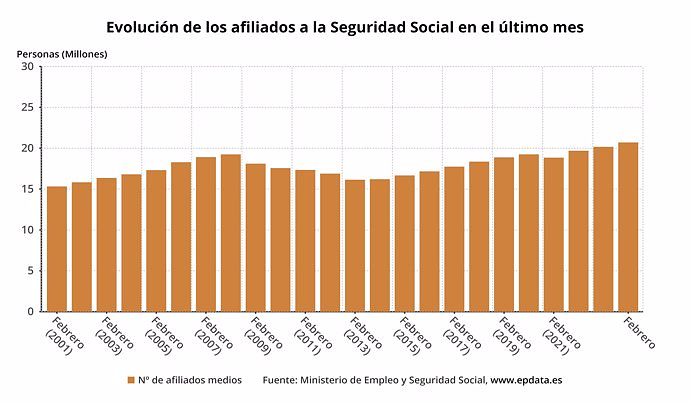In seasonally adjusted values, employment increased in the month by 73,492 people, to a new maximum of 20.95 million workers
MADRID, 4 Mar. (EUROPA PRESS) -
Social Security gained an average of 103,621 contributors in February compared to the previous month (0.5%), its largest increase in this month since 2007, driven by hospitality and education, which between them added almost 60,000 new contributors.
After the increase in February, the number of average affiliates stood at 20,708,382 employed people, its highest level this month within the historical series, according to data published this Monday by the Ministry of Inclusion, Social Security and Migration.
In the last year, Social Security has gained 538,239 affiliates in average values, with a year-on-year growth of almost 2.7%.
In seasonally adjusted terms, the number of Social Security contributors registered a record increase for the month of February of 73,492 affiliates (0.3%), up to a total of 20,954,785 workers, "the best figure in the historical series", The Department headed by Elma Saiz has highlighted.
Within the seasonally adjusted series, 551,359 jobs have been created in the last year and almost 1.6 million compared to December 2019, before the pandemic.
"In February we again recorded historically high levels, with even greater dynamism than previous months, and we see the structural change that the labor reform has brought about," highlighted the Minister of Inclusion, Social Security and Migration, Elma Saiz.
The monthly increase in average affiliates in February was slightly greater among men, who gained 52,807 contributors in the month compared to January (0.48%), compared to an increase in female employment of 50,814 employed women (0.5%).
With this increase, the number of employed men ended February at 10,921,189 contributors, while the number of working women remained among the highest values in the series, with 9,787,193 employed, 47.3% of all affiliates.
The Ministry has also highlighted that more than half of the employment created in the last year, almost 55%, has been occupied by women, with a growth in permanent employment of 5.7%, above that of men (4, 9%).
This has been reflected in their contribution bases, which have increased by 16%, that is, 2.8 points more than those of men, compared to the level before the pandemic. Since then, women's membership has grown by 11.8%, compared to a 7.7% increase in male membership.
"We continue to take steps to reduce the gender gap in the labor market. Women occupy 47.3% of jobs and in 40% of the provinces this percentage is even higher," highlighted Minister Saiz.
For its part, the average affiliation of foreigners increased in February by 39,953 contributors, 1.5% more than the previous month, reaching 2,671,546 employed people.
By regime, the General, the largest in the system, gained 92,857 average affiliates in February (0.5%), up to a total of 17.31 million employed people, while the Self-Employed Regime (RETA) added 10,097 affiliates to its rows (0.3%), which placed the total number of self-employed contributors at 3,337,516.
Within the General Regime, the hospitality industry had the greatest increase in employment, gaining 29,230 contributors compared to the previous month (2.2%). They were followed by education, with 28,941 more members (2.3%); construction (18,189 contributors, 1.9%), and the manufacturing industry, which gained 13,130 employees (0.7%).
On the other hand, the largest monthly declines in employment occurred in healthcare activities, with 10,252 fewer members (-0.5%), and in commerce, which lost 9,590 contributors (-0.4%).
For its part, the Special Agrarian System lost 3,975 members in the second month of the year (-0.6%), and the Home System added 1,230 new members (0.3%).
The Ministry has highlighted that the growth in membership compared to the pre-pandemic level is "especially intense" in sectors with high added value, such as IT and telecommunications, which has 26.3% more members than before Covid. or professional, scientific and technical activities, where employment has increased by 16.6%.
In fact, according to Social Security, more than one in five new affiliates, that is, 329,000 people, have joined these two "highly productive" sectors since the pandemic ended.
Many of these jobs have been filled by young people. From the pre-Covid level, Social Security affiliation of those under 30 years of age has increased by 14.8%, more than five points above the average increase in employment.
According to the Ministry, the February data reflect the positive effects of the labor reform on the stability of employment and the improvement in its quality since this regulation came into force two years ago.
Thus, the percentage of members with a temporary contract fell in February to 12.7%, a historic low, compared to the average of 30% before the labor reform. Thus, the percentage of employed people with permanent contracts stood at 87.3% in February after growing 17.3 points since the arrival of the labor reform. In the case of those under 30 years of age, temporary employment has been reduced by 33.6 points, to 19.4%.
At the same time, Social Security now has more than 3.1 million more members with a permanent contract than in December 2021, the last month before the entry into force of the labor reform.
In the last year, members with full-time indefinite contracts have increased by 5.2% (467,034 employed), above those with part-time contracts (5.1%, 117,628) and in contrast to the decrease of 0. 2% of permanent-discontinuous members (-1,419 members).
The Ministry has also highlighted that, compared to large European countries, job creation in Spain from the pre-Covid level has increased by 8.1%, above the rates in France (5%), Italy (2 .9%) and Germany (1.4%). The same happens if we look at the gain in employment since the war began in Ukraine: while in Spain employment has grown by 5.9%, in France and Germany it has grown by less than 2%.
The average affiliation increased in February in all the autonomous communities except in Castilla-La Mancha, where it fell by 1,314 employees (-0.17%).
The largest increases in employment, in absolute terms, were recorded in Catalonia, which gained 23,637 members; Andalusia (18,325 employed); Balearic Islands (14,808 contributors), and Madrid (12,648).
In relative terms, the greatest monthly increases in average occupancy were for the Balearic Islands (3.2%), Murcia (1%) and Catalonia (0.6%).
On the other hand, the Ministry has reported that workers in ERTE for economic, technical, organizational or production reasons (ETOP) stood at 9,435 at the end of February.
In total, as of February 29, there were 10,672 workers in ERTE, of which 9,230 were in an ERTE-ETOP and 1,237 in an ERTE due to force majeure.

 Exploring Cardano: Inner Workings and Advantages of this Cryptocurrency
Exploring Cardano: Inner Workings and Advantages of this Cryptocurrency Seville.- Economy.- Innova.- STSA inaugurates its new painting and sealing hangar in San Pablo, for 18 million
Seville.- Economy.- Innova.- STSA inaugurates its new painting and sealing hangar in San Pablo, for 18 million Innova.- More than 300 volunteers join the Andalucía Compromiso Digital network in one month to facilitate access to ICT
Innova.- More than 300 volunteers join the Andalucía Compromiso Digital network in one month to facilitate access to ICT Innova.-AMP.- Ayesa acquires 51% of Sadiel, which will create new technological engineering products and expand markets
Innova.-AMP.- Ayesa acquires 51% of Sadiel, which will create new technological engineering products and expand markets AstraZeneca admits that its Covid vaccine can cause side effects such as thrombosis in "very rare cases"
AstraZeneca admits that its Covid vaccine can cause side effects such as thrombosis in "very rare cases" The PP signs the director of the cabinet of the governor of the Bank of Spain for its list for the European elections
The PP signs the director of the cabinet of the governor of the Bank of Spain for its list for the European elections Illa does not rule out agreeing with Junts after the Catalans if they do not prioritize independence
Illa does not rule out agreeing with Junts after the Catalans if they do not prioritize independence Los Angeles Police begin to dismantle the encampment at the University of California
Los Angeles Police begin to dismantle the encampment at the University of California How Blockchain in being used to shape the future
How Blockchain in being used to shape the future Not just BTC and ETH: Here Are Some More Interesting Coins Worth Focusing on
Not just BTC and ETH: Here Are Some More Interesting Coins Worth Focusing on UPV students design an app that helps improve the ventilation of homes in the face of high temperatures
UPV students design an app that helps improve the ventilation of homes in the face of high temperatures Ivace and promotes a less invasive device for the early detection of prostate cancer
Ivace and promotes a less invasive device for the early detection of prostate cancer Valencia unanimously approves the ordinance to allocate spaces to test innovative initiatives
Valencia unanimously approves the ordinance to allocate spaces to test innovative initiatives UPV researchers promote a paid master's degree as a "talent factory" in integrated photonics
UPV researchers promote a paid master's degree as a "talent factory" in integrated photonics A million people demonstrate in France against Macron's pension reform
A million people demonstrate in France against Macron's pension reform Russia launches several missiles against "critical infrastructure" in the city of Zaporizhia
Russia launches several missiles against "critical infrastructure" in the city of Zaporizhia A "procession" remembers the dead of the Calabria shipwreck as bodies continue to wash up on the shore
A "procession" remembers the dead of the Calabria shipwreck as bodies continue to wash up on the shore Prison sentences handed down for three prominent Hong Kong pro-democracy activists
Prison sentences handed down for three prominent Hong Kong pro-democracy activists ETH continues to leave trading platforms, Ethereum balance on exchanges lowest in 3 years
ETH continues to leave trading platforms, Ethereum balance on exchanges lowest in 3 years Investors invest $450 million in Consensys, Ethereum incubator now valued at $7 billion
Investors invest $450 million in Consensys, Ethereum incubator now valued at $7 billion Alchemy Integrates Ethereum L2 Product Starknet to Enhance Web3 Scalability at a Price 100x Lower Than L1 Fees
Alchemy Integrates Ethereum L2 Product Starknet to Enhance Web3 Scalability at a Price 100x Lower Than L1 Fees Mining Report: Bitcoin's Electricity Consumption Declines by 25% in Q1 2022
Mining Report: Bitcoin's Electricity Consumption Declines by 25% in Q1 2022 Oil-to-Bitcoin Mining Firm Crusoe Energy Systems Raised $505 Million
Oil-to-Bitcoin Mining Firm Crusoe Energy Systems Raised $505 Million Microbt reveals the latest Bitcoin mining rigs -- Machines produce up to 126 TH/s with custom 5nm chip design
Microbt reveals the latest Bitcoin mining rigs -- Machines produce up to 126 TH/s with custom 5nm chip design Bitcoin's Mining Difficulty Hits a Lifetime High, With More Than 90% of BTC Supply Issued
Bitcoin's Mining Difficulty Hits a Lifetime High, With More Than 90% of BTC Supply Issued The Biggest Movers are Near, EOS, and RUNE during Friday's Selloff
The Biggest Movers are Near, EOS, and RUNE during Friday's Selloff Global Markets Spooked by a Hawkish Fed and Covid, Stocks and Crypto Gain After Musk Buys Twitter
Global Markets Spooked by a Hawkish Fed and Covid, Stocks and Crypto Gain After Musk Buys Twitter Bitso to offset carbon emissions from the Trading Platform's ERC20, ETH, and BTC Transactions
Bitso to offset carbon emissions from the Trading Platform's ERC20, ETH, and BTC Transactions Draftkings Announces 2022 College Hoops NFT Selection for March Madness
Draftkings Announces 2022 College Hoops NFT Selection for March Madness























